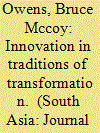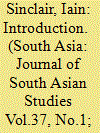| Srl | Item |
| 1 |
ID:
132286


|
|
|
|
|
| Publication |
2014.
|
| Summary/Abstract |
The Newar monastic compounds of the Kathmandu Valley (b?h??s and bah?s) are the centres of what is arguably the world's oldest continuously practised form of Buddhism. This article presents a preliminary analysis of a survey that revisited these compounds 25 years after the publication of John Locke's exhaustive study in order to understand how these fundamental institutions of Newar Buddhism have been affected by the radical transformations that Nepalese society has undergone since then. It suggests that Newar practitioners of the dharma have often expressed their devotion in ways that are at once traditional and vitally innovative, transforming these compounds as well as the means through which they transform them in myriad ways. The conspicuous democratisation of sponsorship of 'repairs' has resulted in alterations that conform to notions of authenticity-old and new, Newar and foreign-as well as deliberate departures from tradition.
|
|
|
|
|
|
|
|
|
|
|
|
|
|
|
|
| 2 |
ID:
132278


|
|
|
|
|
| Publication |
2014.
|
| Summary/Abstract |
Michael Allen is a pioneering figure in the study of the Newars, the indigenous people of Nepal's Kathmandu Valley. Allen carried out his main fieldwork in Nepal between the mid 1960s and late 1970s and enjoyed a successful academic career, twice acting as head of the Department of Anthropology at the University of Sydney between 1985 and 1991. While Allen is also well known for his studies of cults in settings as disparate as Vanuatu and Ireland-and after retirement was honoured by colleagues for his 'commitment to the comparative method' with a festschrift published in 2001 -his work on the Newars remains especially vital and worth re-visiting. The population, environment and government of Nepal have all changed greatly in recent decades; at the same time, the significance of Newar religion is beginning to be more widely appreciated. In this special section of South Asia we re-examine some of the rituals, institutions and traditions treated by Allen in four new papers, contributed by scholars around the world.
|
|
|
|
|
|
|
|
|
|
|
|
|
|
|
|
| 3 |
ID:
169024


|
|
|
|
|
| Summary/Abstract |
Development policy and practice is replete with assumptions that local “communities” have both the willingness and capability to adapt to socio-environmental changes and become “resilient” to multiple old and new challenges. This paper analyzes socio-environmental change processes in a dynamic peri-urban context in the Kathmandu Valley of Nepal, and argues that unequal power relations between diverse actors and their differing interests refute notions of “collective action” and “community resilience.” Residents of peri-urban communities are diverse, have varying abilities and interests, and use different strategies and actions in response to complex socio-environmental changes. These differences reduce insecurities for some while reproducing inequalities for others. These interrelations at the local level are driven by wider socio-economic, political, and institutional processes that transcend community boundaries, interests, and benefits. In the face of these complexities, “community resilience” is an unviable, externally defined, and engineered goal, often at odds with the power discrepancies and heterogeneity found within actual communities. These findings suggest a need to pay attention to the social, economic, and political dynamics of socio-environmental changes that simultaneously shape local communities and their members’ abilities to respond to changes at various scales.
|
|
|
|
|
|
|
|
|
|
|
|
|
|
|
|